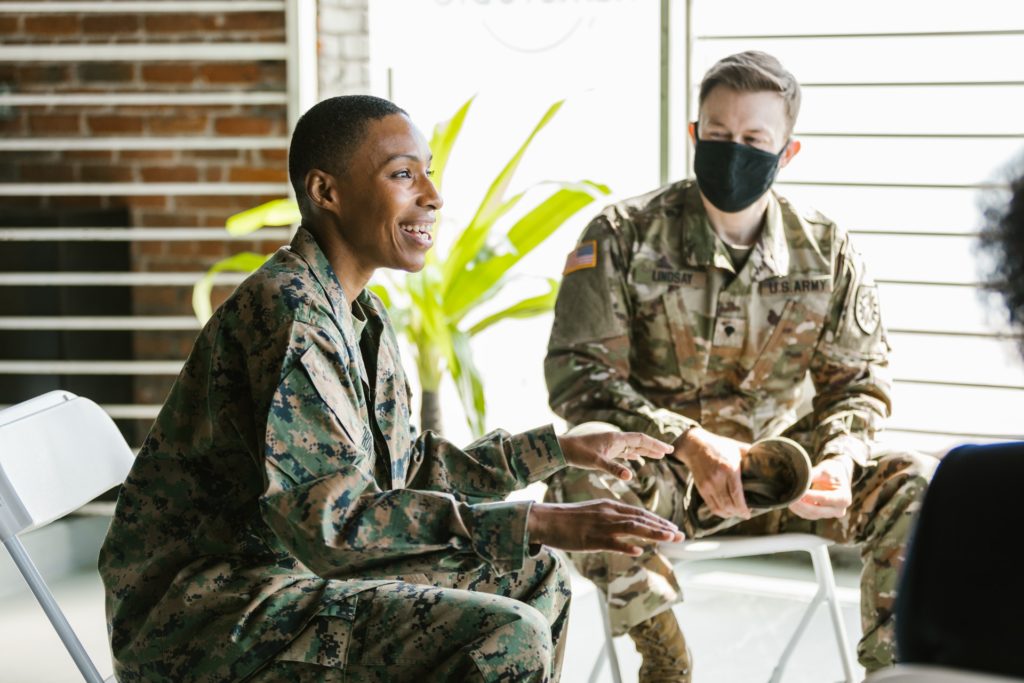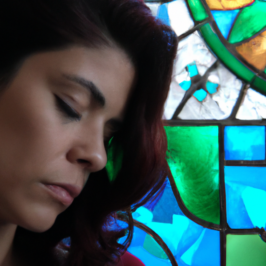
By: Colette Shade, LMSW
After last August’s evacuation from Afghanistan, many military veterans were confronted with a harsh, sudden end to the longest war in American history. Gone was the bluster and chest-thumping confidence of early-2000s America. Both the recently deployed and those who have been stateside for years were left to face their own feelings around the war they’d fought in finally ending, with the majority of Afghanistan war veterans backing President Biden’s decision to withdraw but far fewer calling their efforts “successful.” For some, the dissolution of their efforts brought up more than just frustration, like feelings of grief and emotional triggers, and reminded us all that trauma is often more complicated than a direct cause and effect. Instead, its causes can be surprising, and its effects can show up long after we’d expect, making trauma seem, to many people, like a tangled tripwire rather than a natural reaction to an unnatural event.
Perhaps the best-known aftereffect of war on veterans is post-traumatic stress disorder (PTSD). According to the U.S. Department of Veterans’ Affairs, about 11-20% of veterans who served in Operations Iraqi Freedom and Enduring Freedom (primarily referring to the war in Afghanistan) deal with PTSD. Despite its prevalence, deeper understanding of PTSD and the way it presents remains misunderstood by many people. According to the American Psychiatric Association’s Diagnostic and Statistical Manual (DSM-5), a PTSD diagnosis requires:
- Exposure to actual or threatened death, serious injury, or sexual violence in one (or more) of the following ways:
- Directly experiencing the traumatic event(s).
- Witnessing, in person, the event(s) as it occurred to others.
- Learning that the traumatic event(s) occurred to a close family member or close friend. In cases of actual or threatened death of a family member or friend, the event(s) must have been violent or accidental.
- Experiencing repeated or extreme exposure to aversive details of the traumatic event(s) (e.g., first responders collecting human remains; police officers repeatedly exposed to details of child abuse). Note: this does not apply to exposure through electronic media, television, movies, or pictures, unless this exposure is work related.
- Presence of intrusion symptoms associated with the traumatic event(s), beginning after the traumatic event(s) occurred (like nightmares, flashbacks, physical reactivity etc.).
- Persistent avoidance of stimuli associated with the traumatic event(s), beginning after the traumatic event(s) occurred.
- Negative alterations in cognitions and mood associated with the traumatic event(s), beginning or worsening after the traumatic event(s) occurred (like a persistent low mood or negative beliefs).
- Marked alterations in arousal and reactivity associated with the traumatic event(s), beginning or worsening after the traumatic event(s) occurred (like irritability, hypervigilance, difficulty concentrating, etc.).
- Duration of the disturbance (Criteria B, C, D, and E) is more than 1 month.
- The disturbance causes clinically significant distress or impairment in social, occupational, or other important areas of functioning.
- The disturbance is not attributable to the physiological effects of a substance (e.g., medication, alcohol) or another medical condition.
PTSD is a relatively new name for a very old series of symptoms, though. Even though the diagnosis was added to the DSM-III in 1980 to respond to an influx of Vietnam War veterans, it can be traced back over thousands of years through accounts of past wars, either by previous terms like “Nostalgia” and “Shell Shock” or in descriptions of symptoms that closely mirror our modern understanding of trauma. The first record of symptoms matching PTSD can be found in Herodotus’ telling of the Battle of Marathon (490 B.C.).
Epizelus…was in the thick of the fray and behaving himself as a brave man should, when suddenly he was stricken with blindness, without blow of sword or dart; and this blindness continued thenceforth during the whole of his afterlife. He said that a gigantic warrior…stood over against him; but the ghostly semblance passed him by and slew the man at his side.
The customs of many ancient cultures (even those that never made contact with each other) give clues that PTSD has been understood for thousands of years, if not neurologically then emotionally and spiritually. Vestal virgins would bathe Roman soldiers returning from war. Aztec and Olmec warriors participated in sweat lodge rituals before they could come home. Gikuyu warriors of Kenya had their heads shaved and performed purifying rituals in case any curses had been put on them during battle. Even Shakespeare writes about “Queen Mab” in Romeo & Juliet with a striking similarity to the second PTSD criterion in the DSM-5 (nightmares, flashbacks, physical reactivity): “Sometime she driveth over a soldier’s neck and then dreams he of cutting foreign throats…at which he starts and wakes, and being thus frighted, swears a prayer or two and sleeps again.”
Trauma, especially in veterans, is often framed around combat and largely understood as an immediate response to danger, yet only about ten percent of service members engage in battle and nearly half never see combat at all. The requirement you won’t see above, or anywhere else for a PTSD diagnosis, is that an individual must experience direct exposure to a life-threatening event; this requirement was eliminated when the APA published its latest version of the DSM in 2013 to reflect a better understanding of how trauma can affect people. Craig Bryan, Executive Director at the National Center for Veterans Studies, says, “They have been exposed to atrocities or other events that have a significant effect on their worldview, sense of self, etc.. People can struggle with mental-health problems even if they haven’t been in combat.” The U.S. Department of Veterans’ Affairs also notes that 23% of women in the military have experienced sexual assault, and 55% of women and 38% of men have experienced sexual harassment. The VA does not offer statistics for male sexual assault, but the RAND Corporation has found that the number stands at 1.7%, with an additional 23% of men experiencing other types of sexual violence.
These issues and others have led to an epidemic of military suicides so severe that deaths due to suicide are more than four times higher than deaths due to war. Thomas Suitt, of Brown University’s Cost of War Project, says:
The prevalence of improvised explosive devices, or IEDs, creates an atmosphere of fear among service members and the possibility of traumatic brain injuries if they are hurt in an explosion. Modern medical advances have made it possible for service members to survive more serious injuries and even be redeployed.
It’s no coincidence that trash piles – which often hide IEDs in active warzones – are a common trigger for Iraq War veterans when they return home; when soldiers learn how dangerous seemingly harmless roadside trash can really be, it can be hard to unlearn. Compounding this problem is the issue of stigma. A 2013 study in the Journal of Psychiatric Rehabilitation found that “common perceived stereotypes of treatment-seeking veterans with PTSD included labels such as ‘dangerous/violent,’ or ‘crazy,’ and a belief that combat veterans are responsible for having PTSD.” Those in the military community (active-duty personnel, veterans, and their family members) are even more likely than civilian Americans to hold negative views of people suffering with PTSD, being twice as likely to believe these stereotypes and 35% believing that PTSD is not treatable.
In actuality, our understanding of PTSD and its treatment is constantly evolving. While chemical treatments like anesthetic injections and ketamine infusions are still being studied, risk factors in developing PTSD after trauma are becoming much clearer. Veterans are more likely to transition to civilian life without developing PTSD or other mental illnesses if they have, among other factors:
- an absence of childhood trauma
- access to continuing education
- a support system of close family and friends
- easy access to a clinic
On the flip side, they are more likely to develop PTSD and be a risk to themselves and others under stressors like:
- drug and alcohol misuse
- financial instability
- poor social support
Some therapists even specialize in working with veterans and the specific care they may require. Additionally, the VA also offers many support groups for veterans and resources such as The Veterans Crisis Line offers immediate help for veterans experiencing suicidal thoughts.
We should be thankful, then, that the Headstrong Project, which provides mental health treatment to veterans, saw a 66% increase in requests for therapy after the evacuation from Afghanistan, and the Veterans Crisis Line saw 5% more calls, 66% more texts and 31% more web chats. Many people have heard stories about fathers and grandfathers who came back from war and never spoke about their service, just keeping a secret second life that would only ever belong to them. It’s easy to think it’s all part of “being a man” and “the strong, silent type” for older generations, but the physical symptoms many veterans developed – like stuttering, mutism, trembling, and bed wetting – are harder to ignore. They completely match some of the things Afghanistan and Iraq veterans have dealt with over the past twenty years. Looking back at how many ancient cultures understood the deep need to process trauma, it starts to look like our modern ideas around PTSD aren’t new at all; the image that veterans are “crazy” or “dangerous” if they need help was the different way of thinking, and it’s one that’s being confronted more and more.
Veterans in the Baltimore-area looking for more resources can check out Maryland Therapeutic Riding for free equine-assisted therapy and help with post-traumatic stress disorder, traumatic brain injury, depression, anxiety, and amputation.
DISCLAIMER
The information, including but not limited to, text, graphics, images and other material contained on this website are for informational purposes only. No material on this site is intended to be a substitute for professional medical advice, diagnosis, or treatment. Always seek the advice of your physician or other qualified healthcare provider with any questions you may have regarding a medical condition or treatment and before undertaking a new health care regimen, and never disregard professional medical advice or delay in seeking it because of something you have read on this website.






